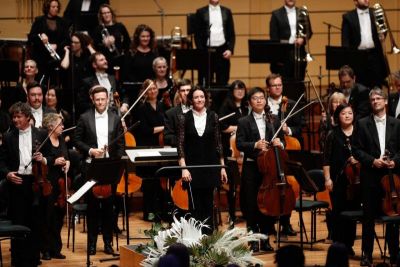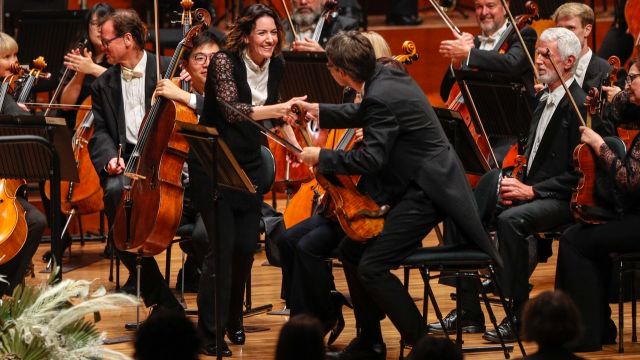Timeless: Alondra’s Season Finale
Alondra de la Parra’s three years at the helm of the QSO came to a close in Brisbane with a celebratory and emotional concert presentation with two performances at QPAC – a shorter matinee concert on the Friday and a full programme on Saturday night. And judging by the diversity of the audiences at both events, the QSO’s aim of introducing more people to music has been a smashing success. In fact, to allow as many people to see the finale as possible – Timeless was also live-streamed on social media and beamed into a number of venues across Queensland (Gladstone, Toowoomba, Nambour, Longreach, Charters Towers, Beaudesert, Gympie, Wesley Mission Centres and Hospital). Timeless will also be broadcast on Mexican and North American TV channels in the coming weeks. What a brilliant way to put Brisbane on the cultural map.
This is a first for the QSO – a status the group has become quite adept at – Alondra de la Parra is the first female principal conductor of an Australian symphony orchestra and QSO’s first-ever musical director. She is also the first Mexican woman to conduct in New York City. As well as her many musical achievements, Alondra was voted 2018 Woman of the Year and is a cultural ambassador for Mexico, the country she grew up in and where she studied music until her late teens. She has also been awarded for her work with ground-breaking Simón Bolivar Youth Orchestra. And, like that orchestra’s famous Maestro, Gustavo Dudamel, she has enlivened the post of conductor, adding a role as inspirational entertainer as well as interpreter and leader. This is a style that is changing the accessibility of classical music. As my friend, not too familiar with the classics, said on Saturday night: “It’s all rock ‘n’ roll – just different instruments!” And Alondra de la Parra proved herself to be Queensland’s own rock star conductor.
The pieces for this finale concert – chosen by de la Parra and QSO’s Artistic Committee – aptly reflect diversity and emotion. As shown in his featured piece, Rapsodie espagnol, Maurice Ravel’s Basque heritage and the influence of Spanish folk music comes through. His work is also celebratory, with festival and carnival connotations. It is relaxing and exhilarating at the same time.
 Norwegian Edvard Grieg studied in Leipzig in Germany. He, too, was interested in the folk music of his heritage. Piano Concerto in A minor (Op. 16) is dramatic and memorable. Its star instrument is the piano, played by artist-in-residence, the internationally renowned British pianist, Paul Lewis CBE. His passionate playing is something to experience. With de la Parra ‘conducting’ with a mere nod and gentle head tilt, the duo perform with effortless ease, like two sympatico friends out for a brisk stroll.
Norwegian Edvard Grieg studied in Leipzig in Germany. He, too, was interested in the folk music of his heritage. Piano Concerto in A minor (Op. 16) is dramatic and memorable. Its star instrument is the piano, played by artist-in-residence, the internationally renowned British pianist, Paul Lewis CBE. His passionate playing is something to experience. With de la Parra ‘conducting’ with a mere nod and gentle head tilt, the duo perform with effortless ease, like two sympatico friends out for a brisk stroll.
The trio of featured pieces is completed by the crowd-pleasing Russian composer, Tchaikovsky, with his recognisable Symphony No. 5 in E minor (Op. 64). It leads to a vital and moving finale that is absolutely fitting to the occasion – exhilarating and full of longing. This is a celebration – and de la Parra conducts to bring out the very best in all her musicians. It is really something to see the players of eight huge double basses lean in to meet the gaze of the conductor, to judge her mood. The conductor’s energy emits to every inch of her performers, across a wave of violinists, cellists, magical reed and horn players, harpists, to the beautiful beat of the timpani and finesse of fine percussion. The balance is held in check by calm Concert Master, Warwick Adeney, who has obviously nurtured a strong creative bond to his musical director and conductor.
Alondra rewards her musicians with a warmth that is palpable. She is energetic and enigmatic, moving like a film performer, an athlete, a dancer, a painter. Her approach is supportive and she rewards her performers with a smile or nod. This is no style over substance – the technique achieves excellence in balance in tone, sound and pace from the extremely talented QSO musicians. Alondra has said: “We strive for perfection together.” And this is an ensemble achievement.
 The benefits of the creative collaborations involved are obvious. They are also important for Australian talent to flourish. This is because of sheer distance and expense – our artists simply do not have the luxury of their European or Transatlantic counterparts to catch a cheap flight to see a performance or study with the best. We almost have to insist that the talent comes to us. Importantly, this work is backed by sponsors – and what a great illustration in the University of Queensland’s support for UK pianist Paul Lewis as artist in residence. A host of other corporate sponsors are also involved to help widen the reach of the QSO’s programmes – and I’m sure there were many people across regional Queensland thanking them for this opportunity on Saturday night.
The benefits of the creative collaborations involved are obvious. They are also important for Australian talent to flourish. This is because of sheer distance and expense – our artists simply do not have the luxury of their European or Transatlantic counterparts to catch a cheap flight to see a performance or study with the best. We almost have to insist that the talent comes to us. Importantly, this work is backed by sponsors – and what a great illustration in the University of Queensland’s support for UK pianist Paul Lewis as artist in residence. A host of other corporate sponsors are also involved to help widen the reach of the QSO’s programmes – and I’m sure there were many people across regional Queensland thanking them for this opportunity on Saturday night.
Timelesswas the perfect mix of celebration, drama and emotion. The QSO’s parting gift to their deeply loved conductor and colleague was a lively Latino number, proving that these classically trained musicians can break out of the 4/4 timing and get in the groove. In her farewell speech, Alondra thanked her orchestra, her team, her family – she also thanked the Brisbane community for accepting her and her family. She says she will always call Brisbane ‘home’ – and there was a packed audience in QPAC’s Concert Hall who will hope that she comes home again soon.
Beth Keehn
Photo credit: Peter Wallis
Subscribe to our E-Newsletter, buy our latest print edition or find a Performing Arts book at Book Nook.

